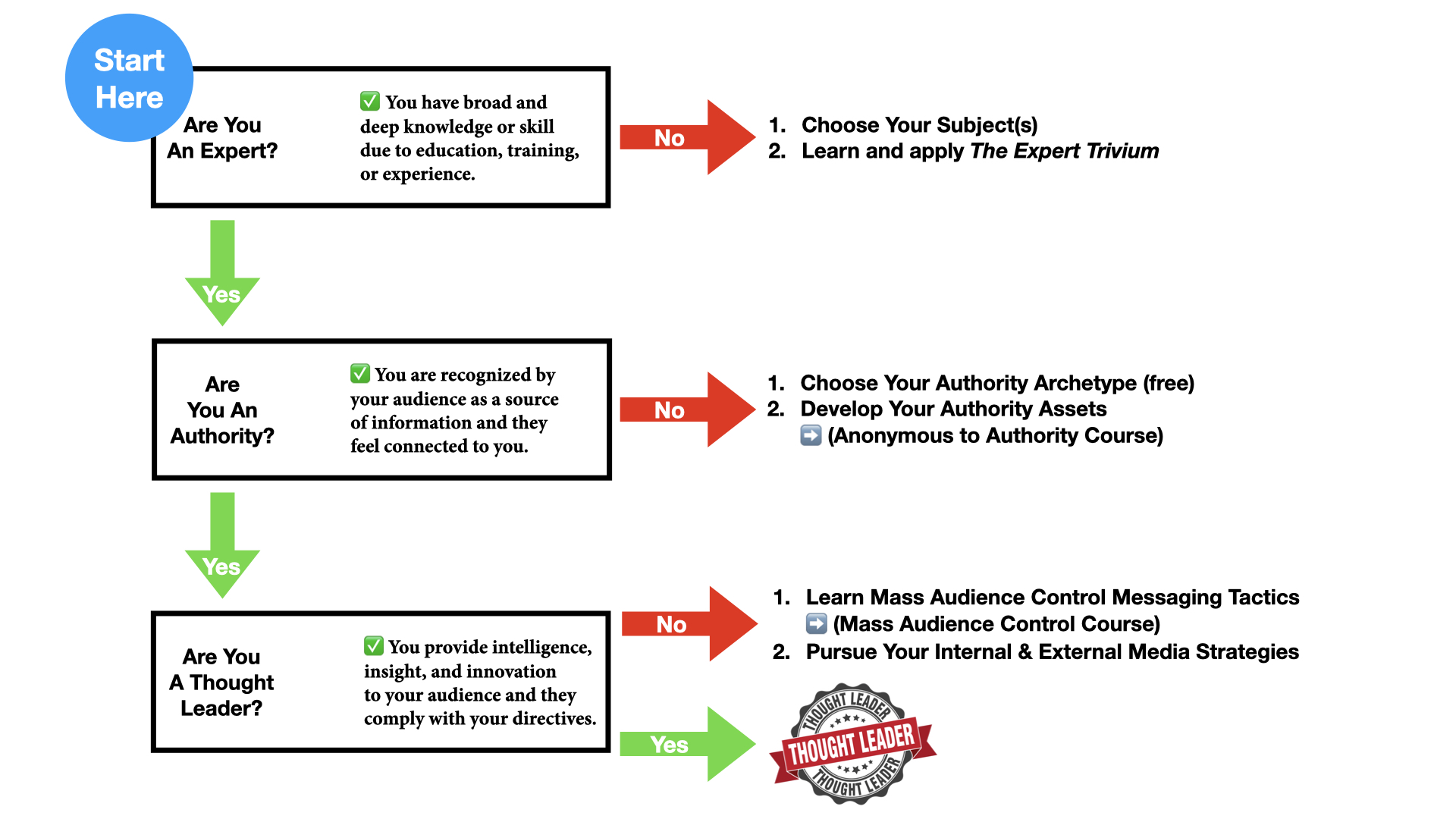When we talk about being an Expert, Authority, or Thought Leader, we are actually identifying three different roles in society. The three roles have to do with varying levels of expertise and also three different relationships with an audience, if there is an audience at all.
I’m going to attempt to map out these roles for you, help you decide the best role for you, and show you how to become an Authority or Thought Leader.
The good news is, you may already be an Expert.
Sounds like the opening line from an old Publisher’s Clearing House sales letter, doesn’t it? “Congratulations, you may already be a winner!”
An Expert is a person with a particular body of knowledge or skills. An Expert may have earned their expertise through experience, education, or both. Sometimes, someone is a covert Expert — even their friends and family may not even know of their expertise. Other times, the results of their experience are visible enough that lots of people know.
Sometimes, people are just happy being experts, but lots of Experts have a desire to help people, create a legacy, and get paid for their knowledge.
So how do you get there from here? Let’s first make some distinctions between an Authority and a Thought Leader.
Both roles have to do with teaching and learning.
I think a good working definition of learning is “building a mental map of understanding.”
When you hear the word “map,” you probably think of a geographic map, like a map of your country or even a globe. But there are other maps as well, like a process map, flowchart, or a decision tree. In short, a map is something to tell you where you are in a place, process, or concept, and can help you get to where you want to go.
As we learn, we are all building many mental maps in our heads. When you start learning a new subject, your map is incomplete and quite unsophisticated. As you learn more, you add to that map and it becomes more complex and detailed. These mental maps (and the ability to communicate them) are the calling card of an Authority or Thought Leader.
An Authority or Thought Leader helps people in their audience fill in that map through teaching. As they help that audience fill in their maps, they supply wisdom that is especially applicable to the needs of that audience. The Authority then build a two-way emotional connection (most would-be Authorities fail to take that step).
Additionally, it should be noted that there are a number of relational roles the Authority or Thought Leader can assume to build that connection with the audience. As I train would-be Authorities or Thought Leaders, one of the key steps is helping them pick the best relational role. For example, the “Investigator” role is great for people who wouldn’t personally serve as a great example, but they have collected lots of best practice data and share that with their audience. There is also the “Tactical Advocate,” who has a proprietary methodology or system that they teach.
There are two key differences between an Authority and Thought Leader. One difference is that a Thought Leader is an Authority who adds innovation. Not only does a Thought Leader need to be an Authority, but they also need to be innovative in their understanding and teaching of a subject, and that innovation must be recognized by their audience. They use their knowledge and experience to pull new ideas from the future into present reality. They challenge norms and come up with new ways of doing things and new ways to solve problems.
I used to think that being innovative is a quality one either does or does not have, like being tall or being generous. You can’t teach a short person how to be tall, and I think it’s probably awfully difficult to teach someone how to be generous.
As I’ve studied more and more Thought Leaders throughout history (mainly over the last few hundred years), I’ve learned that innovation is in fact a skill that has specific tools and tactics for solving problems and generating new ideas. It’s not as hard as it sounds.
Another key difference between an Authority and a Thought Leader has to do with the second word in “Thought Leader.”
The one thing that every leader has is followers. While an Authority will be perceived as a great source of information, the audience of a Thought Leader tends to exhibit a high level of compliance to the directions of their leader. This is what makes being a Thought Leader worthwhile, to the benefit of both the Thought Leader and the audience.
Before you can become a Thought Leader, you must first be a Thought Follower. The saying that we are all “standing on the shoulders of giants” is absolutely true. Nearly everything a thought leader teaches has been developed and propagated by past Thought Leaders.
Fortunately, history provides us with a deep and rich library of case studies that we can use to spot the patterns of Thought Leadership. By identifying your Authority Archetype, you can begin to adapt their strategies to your goals. It is a foolish and expensive mistake to fail to find the archetype that works best for you.
When you attempt to become an Authority or Thought Leader, you are really seeking to build status within an audience. The status of the Authority or Thought Leader is the source of the power of their role. If this status build isn’t done correctly, you get about as much of a payoff as the Encyclopedia Britannica… everyone knows it’s brilliant but nobody buys or reads it anymore.
In my virtual workshop classes, you will develop the tools and assets to go from Anonymous to Authority, and then from Authority to Thought Leader. The next class is forming soon, and slots are available for qualified Experts. If you think this experience might be right for you, I invite you to apply for an entrance interview.
Your Next Step
Take my fast, free quiz to learn your Authority Archetype. You don’t need to re-invent the wheel! This quiz will point you to resources you can use to begin adapting the proven strategies from the lives of thought leaders throughout history to your business and your specific goals.

